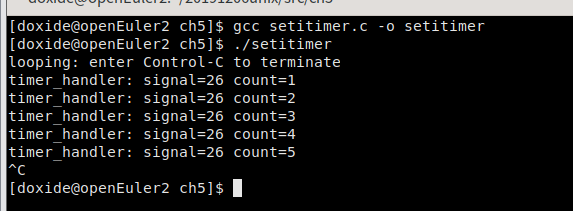学习笔记
知识点归纳
定时器是由时钟源和可编程计数器组成的硬件
时钟源通常是一个晶体震荡器,产生周期性电信号
当计数器减为0时,向CPU生成定时器中断
当CPU遇到异常时,会进行预设的异常处理
中断是外部设备请求CPU服务
CPU是否处理中断取决于它的状态寄存器是否屏蔽了中断
问题与解决思路
中断是如何实现的?
中断的本质是处理器对外开放的实时受控接口。
一个没有中断的计算机体系是决定论的:得知某个时刻CPU和内存的全部数据状态,就可以推衍出未来的全部过程。这样的计算机无法交互,只是个加速器。
添加中断后,计算机指定了会兼容哪些外部命令,并设定服务程序,这种服务可能打断当前任务。这使得CPU“正在执行的程序”与“随时可能发生的服务”,二者形成了异步关系,外界输入的引入使得计算机程序不再是决定论。由人实时控制的中断输入,是无法预测的。再将中断响应规则化,推广开,非计算机科学人群就能控制计算机,发挥创造力。
既然硬件能干扰到CPU的正常的指令执行,那么CPU就必须能感知到干扰信号,所谓的干扰信号就是这里所说的中断信号。
CPU的工作粒度是机器指令级别,那么在每条机器指令执行结束后都会检查一下是否中断信号产生。
这里的实现可能是轮询。这就好比你在玩游戏,此时如果有人喊你的名字(中断信号)干扰你玩游戏那么你立刻就能听到
但人的大脑里有一直在轮询“有没有人喊我的名字?有没有人喊我的名字?有没有人喊我的名字?”了吗?并没有。人脑的中断检查机制是及其高效的。
CPU的硬件特性决定中断处理机制也及其高效。
当那个管脚电平变低(或者变高)的时候,cpu就会被打断,并从特定地址开始执行。
就像cpu的reset被拉低的时候一定会复位并从0地址开始执行一样,都是硬件的结构决定的。
实践内容
gettimeofday()
1 #include <stdio.h>
2 #include <stdlib.h>
3 #include <sys/time.h>
4 #include <time.h>
5
6 int main(){
7 struct timeval t;
8 gettimeofday(&t,NULL);
9 printf("sec = %ld , usec = %d\n",t.tv_sec,t.tv_usec);
10 printf((char*)ctime(&t.tv_sec));
11 return 0;
12 }
settimeofday()
1 #include <stdio.h>
2 #include <stdlib.h>
3 #include <sys/time.h>
4 #include <time.h>
5
6 int main(){
7 struct timeval t;
8 t.tv_sec = 123456789;
9 t.tv_usec = 0;
10 int r = settimeofday(&t,NULL);
11 if(!r){
12 printf("settimeofdat() failed\n");
13 return -1;
14 }
15 gettimeofday(&t,NULL);
16 printf("sec = %ld , usec = %ld\n",t.tv_sec,t.tv_usec);
17 printf("%s",ctime(&t.tv_sec));
18 return 0;
19 }
Linux内核能够纠正系统时间和实时时间的偏差
time()
获取以秒为单位的系统时间
1 #include <stdio.h>
2 #include <stdlib.h>
3 #include <time.h>
4
5 int main(){
6 time_t start , end;
7 start = time(NULL);
8 printf("start = %ld\n",start);
9 for(int i=0;i<123456789;i++);
10 end = time(NULL);
11 printf("end = %ld\n",end);
12 printf("time = %ld\n",end-start);
13 return 0;
14 }
setitimer()
1 #include <signal.h>
2 #include <stdio.h>
3 #include <sys/time.h>
4 int count = 0;
5 struct itimerval t;
6 void timer_handler(int sig)
7 {
8 printf("timer_handler: signal=%d count=%d\n", sig, ++count);
9 if (count>=8){
10 printf("cancel timer\n");
11 t.it_value.tv_sec = 0;
12 t.it_value.tv_usec = 0;
13 setitimer(ITIMER_VIRTUAL, &t, NULL);
14 }
15 }
16 int main()
17 {
18 struct itimerval timer;
19 // Install timer_handler as SIGVTALRM signal handler
20 signal(SIGVTALRM, timer_handler);
21 // Configure the timer to expire after 100 msec
22 timer.it_value.tv_sec = 0;
23 timer.it_value.tv_usec = 100000; // 100000 nsec
24 // and every 1 sec afterward
25 timer.it_interval.tv_sec = 1;
26 timer.it_interval.tv_usec = 0;
27 // Start a VIRTUAL itimer
28 setitimer(ITIMER_VIRTUAL, &timer, NULL);
29 printf("looping: enter Control-C to terminate\n");
30 while(1);
31 }



 浙公网安备 33010602011771号
浙公网安备 33010602011771号